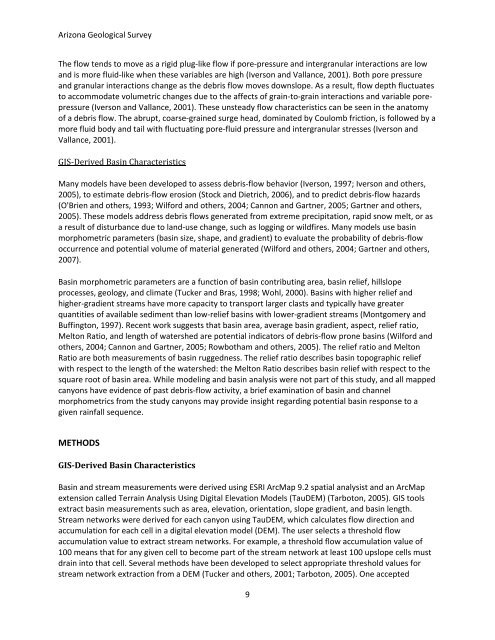Arizona Geological Survey OPEN-FILE REPORT OFR 08-06
Arizona Geological Survey OPEN-FILE REPORT OFR 08-06
Arizona Geological Survey OPEN-FILE REPORT OFR 08-06
Create successful ePaper yourself
Turn your PDF publications into a flip-book with our unique Google optimized e-Paper software.
<strong>Arizona</strong> <strong>Geological</strong> <strong>Survey</strong><br />
The flow tends to move as a rigid plug‐like flow if pore‐pressure and intergranular interactions are low<br />
and is more fluid‐like when these variables are high (Iverson and Vallance, 2001). Both pore pressure<br />
and granular interactions change as the debris flow moves downslope. As a result, flow depth fluctuates<br />
to accommodate volumetric changes due to the affects of grain‐to‐grain interactions and variable porepressure<br />
(Iverson and Vallance, 2001). These unsteady flow characteristics can be seen in the anatomy<br />
of a debris flow. The abrupt, coarse‐grained surge head, dominated by Coulomb friction, is followed by a<br />
more fluid body and tail with fluctuating pore‐fluid pressure and intergranular stresses (Iverson and<br />
Vallance, 2001).<br />
GIS‐Derived Basin Characteristics<br />
Many models have been developed to assess debris‐flow behavior (Iverson, 1997; Iverson and others,<br />
2005), to estimate debris‐flow erosion (Stock and Dietrich, 20<strong>06</strong>), and to predict debris‐flow hazards<br />
(O'Brien and others, 1993; Wilford and others, 2004; Cannon and Gartner, 2005; Gartner and others,<br />
2005). These models address debris flows generated from extreme precipitation, rapid snow melt, or as<br />
a result of disturbance due to land‐use change, such as logging or wildfires. Many models use basin<br />
morphometric parameters (basin size, shape, and gradient) to evaluate the probability of debris‐flow<br />
occurrence and potential volume of material generated (Wilford and others, 2004; Gartner and others,<br />
2007).<br />
Basin morphometric parameters are a function of basin contributing area, basin relief, hillslope<br />
processes, geology, and climate (Tucker and Bras, 1998; Wohl, 2000). Basins with higher relief and<br />
higher‐gradient streams have more capacity to transport larger clasts and typically have greater<br />
quantities of available sediment than low‐relief basins with lower‐gradient streams (Montgomery and<br />
Buffington, 1997). Recent work suggests that basin area, average basin gradient, aspect, relief ratio,<br />
Melton Ratio, and length of watershed are potential indicators of debris‐flow prone basins (Wilford and<br />
others, 2004; Cannon and Gartner, 2005; Rowbotham and others, 2005). The relief ratio and Melton<br />
Ratio are both measurements of basin ruggedness. The relief ratio describes basin topographic relief<br />
with respect to the length of the watershed: the Melton Ratio describes basin relief with respect to the<br />
square root of basin area. While modeling and basin analysis were not part of this study, and all mapped<br />
canyons have evidence of past debris‐flow activity, a brief examination of basin and channel<br />
morphometrics from the study canyons may provide insight regarding potential basin response to a<br />
given rainfall sequence.<br />
METHODS<br />
GISDerived Basin Characteristics<br />
Basin and stream measurements were derived using ESRI ArcMap 9.2 spatial analysist and an ArcMap<br />
extension called Terrain Analysis Using Digital Elevation Models (TauDEM) (Tarboton, 2005). GIS tools<br />
extract basin measurements such as area, elevation, orientation, slope gradient, and basin length.<br />
Stream networks were derived for each canyon using TauDEM, which calculates flow direction and<br />
accumulation for each cell in a digital elevation model (DEM). The user selects a threshold flow<br />
accumulation value to extract stream networks. For example, a threshold flow accumulation value of<br />
100 means that for any given cell to become part of the stream network at least 100 upslope cells must<br />
drain into that cell. Several methods have been developed to select appropriate threshold values for<br />
stream network extraction from a DEM (Tucker and others, 2001; Tarboton, 2005). One accepted<br />
9
















